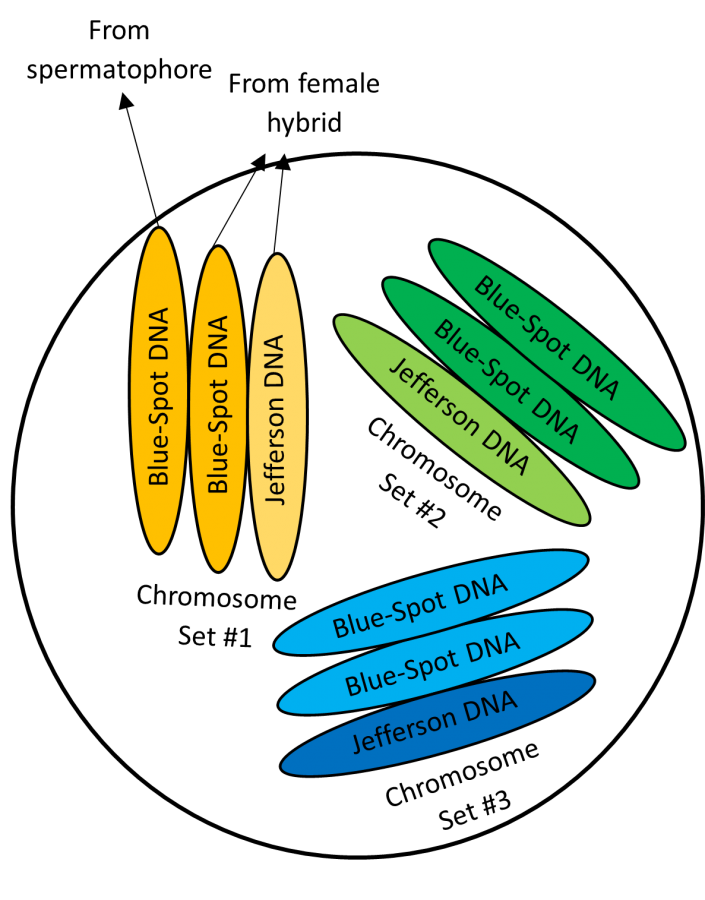New Jersey’s Amphibious Amazons
by Christine Healy, Wildlife Biologist
I felt confident, after the mild conditions that we experienced in January and much of February, that March would skip the “lion” phase of the well-known adage and come in and out like a lamb. I was clearly incorrect…
In anticipation of the amphibian migration, I thought it would be fun to write about some of the most unique adaptations displayed by three early-breeding vernal pool obligates that we target during our Crossing program. These species require access to temporary wetlands in order to complete their life cycles and are thus at greater risk of motor vehicle collisions than other amphibians that don’t rely on these resources. As I started drafting this, I kept thinking about parallels between the behaviors that I chose for each species and superheroes/villains whose background and abilities relate. And so, I’m kicking off this series with our very own Wonder Woman, the Jefferson Salamander.

To understand the “superpower” associated with this one, let’s journey back to high school biology for a minute.
Cells contain genetic information in the form of chromosomes, which look like long strings and feature instructions for different traits like hair and eye color. In organisms that reproduce sexually, cells generally contain chromosomes in pairs of two. Humans, for example, have 46 chromosomes per cell, divided into 23 pairs. These are called diploid. Gametes, or egg and sperm cells, are haploid. They contain half the genetic material as they will combine to yield a complete set of chromosomes in the offspring. If a genetic abnormality occurs that interferes with the creation of a gamete, it is possible for chromosomes to occur in sets of three. This is called triploidy. In humans, it is fatal. In other species, polyploidy (the occurrence of chromosomes in groups > 2) does not interfere with everyday life. Certain salamanders are included in that group, however, the mechanism by which it occurs is pretty unique.

Jefferson and blue-spotted salamanders, two of our local species, can crossbreed to create viable female offspring. These unisexual hybrids require spermatophores (packets of sperm deposited by male salamanders) in order to initiate egg development, but they have some options in terms of what to do with the male’s DNA. This general process is called kleptogenesis.
The first option available to the female is to discard all the genetic material from the stolen sperm and clone herself. Gynogenesis, the specific form of cloning, is not limited to salamanders and occurs more commonly in fish. Alternatively, she can divide her own chromosomes, as typically occurs during sexual reproduction, and combine a portion of her genetic information with that of the spermatophore. This could result in diploid offspring, depending on the genetic makeup of the mother. Finally, she can use all the chromosomes available to her, creating polyploidy females with up to five sets of chromosomes. As if that weren’t wild enough, multiple strategies can be used within a single egg mass.

Tiger salamanders share this ability to create lineages of all female hybrids, but it doesn’t happen in New Jersey because the ranges of these species do not overlap here. They occur only in southern counties while Jefferson and blue-spotted are restricted to the north. In Ohio, on the other hand, these three species, along with two additional ambystomids (small-mouth and streamside salamanders) commonly share pools within the same geographic area. Individuals have been found containing chromosomes from all of them, though never without one set from a blue-spotted salamander. Over 20 combinations of “biotypes”, basically Frankenstein species, have been documented using genetic analysis. You probably don’t need me to tell you that that is remarkable.
While the survival rate for tetraploid and pentaploid biotypes (4 and 5 sets of chromosomes, respectively) are lower than those of diploid and triploid, there are some real advantages to the unisexual strategy. A population composed entirely of females can grow twice as rapidly as one that includes males. Producing males requires the same energetic investment but yields none of the direct reproductive potential. Additionally, the ability to essentially pick and choose which chromosomes to pass onto progeny allows the female to ensure the odds are ever in her larvae’s favor. In pools where one species is better adapted than others, the female can select for that genetic material to give them an edge. Research has proven that this does happen in the wild.

Since blue-spotted salamanders are an endangered species in New Jersey and thus pretty rare, it is likely that, should you find one, it very well could be a Jefferson hybrid. I’ve noticed some blue speckling on some of the Jefferson salamanders that I’ve rescued during my tenure leading the Amphibian Crossing. I wouldn’t be surprised if that’s what they were! Experts may be able to tell based on the width of the head and the size of the spots, but the only way really know, especially if the individual is polyploidy, is by DNA testing.
A lineage of all-female, potentially extra-well adapted salamanders? Sounds like amphibious Amazons to me!
Stay tuned for our next Super Species.
Discover more from Conserve Wildlife Foundation of NJ
Subscribe to get the latest posts sent to your email.
Leave a Comment
What a great series. Terrific writing and fascinating. Thanks so much for this and the ones that followed this.
Comments are closed.